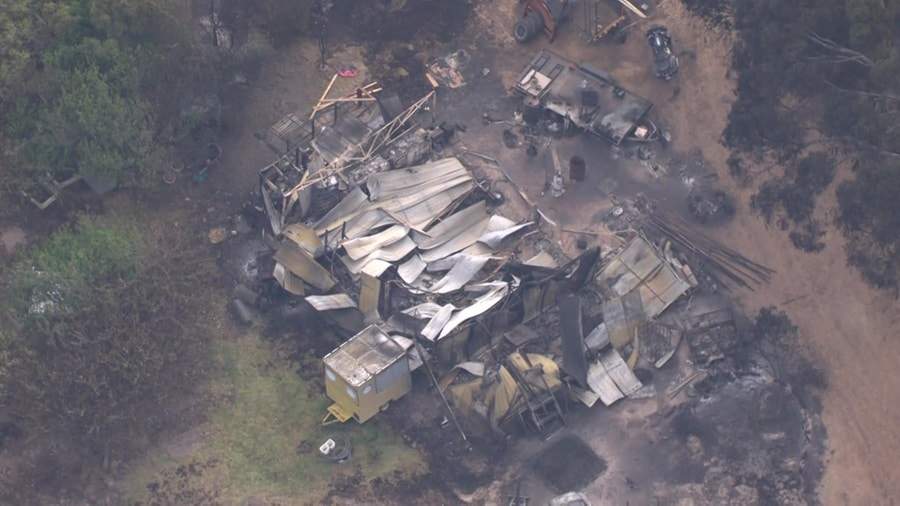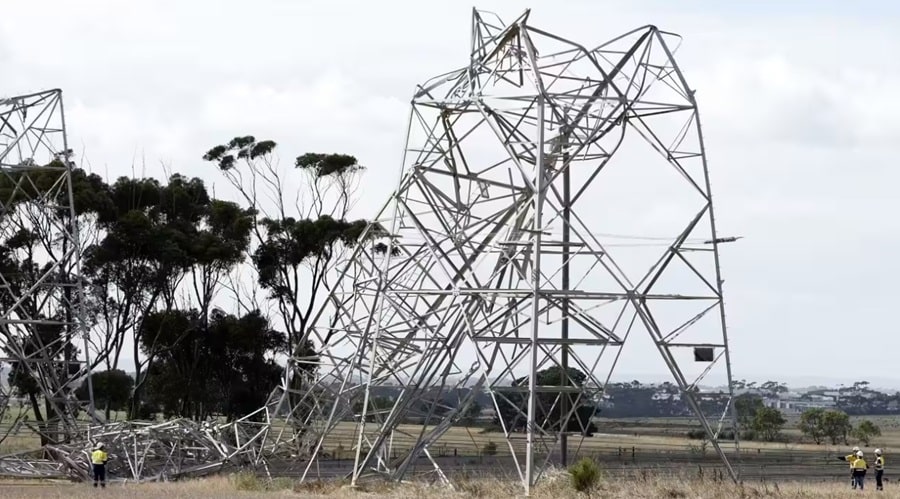A powerful storm ripped through Victoria, Australia on Tuesday, leaving hundreds of thousands of homes without power, disrupting transportation, and claiming the life of a dairy farmer. This comes as the state already battles massive bushfires, further complicated by the extreme weather.
The Victorian government has been criticised for its response to the storms, with some residents accusing it of being slow to react and not providing enough support to those affected. The government has defended its response, saying it is doing everything possible to help those in need.
Widespread power outages
The storm, with its torrential rain and gale-force winds, caused extensive damage to power lines, leading to one of the largest blackouts in Victoria’s history. At the peak, over 529,000 homes were plunged into darkness, with some facing potential outages for weeks. This is due to collapsed transmission towers and a forced shutdown of a power station.
Transportation chaos
The storm’s impact wasn’t limited to power. Public transport in Melbourne was severely disrupted, with half of the city’s train lines suspended due to storm damage. Residents faced communication difficulties with mobile phone outages compounding the power cuts.
Dairy farmer tragedy
Amidst the chaos, a tragedy struck when a 50-year-old dairy farmer in Gippsland was killed, suspected to be hit by flying debris. This highlights the dangers posed by such extreme weather events.
Bushfire efforts thwarted
The wild weather further hampered ongoing efforts to control massive bushfires in western Victoria. A catastrophic fire warning, the highest level of danger, was issued in the Wimmera region, where conditions mirrored those of devastating fires four years ago. Five firefighters sustained minor burns when their vehicle was engulfed by flames.

Emergency relief payments available for fire and storm victims
Emergency relief is here! If your home has been impacted by recent fires or storms, you may be eligible for a hardship payment to help cover essential needs during this difficult time.
What is the payment?
- This is a fixed amount for each member of your household, regardless of your income.
- Adults will receive $640 each.
- Children will receive $320 each.
- The maximum per household is $2,240.
- You can use the funds for necessary expenses like food, clothing, medication, and temporary accommodation.
Who is eligible?
- You may qualify if your primary residence was in an evacuation warning zone or if the fires or storms have damaged your home and your immediate unmet needs.
How to apply?
- Contact your local council at an Emergency Relief Centre or over the phone.
- Bring identification such as a driver’s license, Medicare card, or a letter or utility bill showing your address.
Stay strong, stay informed, and get the help you deserve!
Please note: Specific eligibility criteria, application processes, and deadlines may vary depending on your local council and the specific disaster declaration. Always refer to the official information provided by your local authorities for the most accurate and up-to-date details. For further details check the VIC Emergency website.
Hope emerges
Thankfully, cooler weather on Wednesday brought some relief, allowing authorities to downgrade the fire warning. However, the situation remains tense as Australia continues to grapple with a fire season fueled by dry conditions and hot temperatures.
Climate change concerns
This devastating storm and ongoing fire crisis serve as stark reminders of the increasing frequency and intensity of extreme weather events, which scientists attribute to climate change. The urgency to address climate change and mitigate its impact resonates more than ever.
This storm serves as a wake-up call, highlighting the need for climate action and robust disaster preparedness measures to protect communities and ecosystems from the growing threat of extreme weather events.
Images&Sources: ABC News, BBC News, SBS News
Deadly storms leave Victoria in crisis, highlighting the need for renewable energy and battery storage
The storm knocked out power to hundreds of thousands of people and damaged transmission towers. This event highlighted the need for more resilient energy sources, such as solar power and battery storage.
Solar power is a clean, renewable energy source that can help to reduce reliance on fossil fuels and the associated greenhouse gas emissions. However, solar power is intermittent, meaning it is only available when the sun shines. Battery storage can store solar energy when generated and then release it when needed, such as during power outages.
Use our easy-to-use solar power and battery storage calculator to determine the size of your solar system with storage or even an EV charger! Our solar calculator will generate performance information and potential savings.
We can send this information to 3 trusted local installers in your area to receive obligation-free solar quotes.
Find out how much you can expect to pay for solar
Ready to find out more? Get FREE quotes for solar, batteries + more
*Prices quoted are to be used as a guide only and do not factor in state and other rebates and incentives. Includes STC discount.
The benefits of solar battery storage are numerous
- Reduced reliance on the grid: Solar battery storage can provide backup power to homes and businesses during power outages. This can help to keep essential appliances running, such as refrigerators and medical equipment.
- Lower energy bills: By storing solar energy during the day and using it at night, solar battery storage can help to reduce energy bills.
- Increased energy security: Solar battery storage can help to make the energy grid more resilient to natural disasters and other disruptions.
- Environmental benefits: Solar power is a clean and renewable energy source that does not produce greenhouse gas emissions.
The recent storms have shown the importance of investing in renewable energy and battery storage. These technologies can help to make our energy grid more resilient and sustainable, and they can help to reduce our reliance on fossil fuels.
In addition to the benefits for the environment and the economy, renewable energy and battery storage can provide individual households and businesses with greater energy security. For example, homeowners can reduce their reliance on the grid and protect themselves from power outages by storing solar power.
The Victorian storms have been a wake-up call. They have shown us the need to transition to a more renewable and resilient energy grid. Battery storage is a key part of this transition and technology we should continue to invest in.
Read more about:
- Comprehensive Guide to Storing Solar Energy
- How to Determine Whether a Home Solar Battery Could Result in Cost Savings for Your Family
- Solar Battery Buying Guide: How to Make the Right Decision
- Are Solar Batteries Worth the Investment in Australia Right Now?
- Best Solar Battery Australia 2024
- Do Solar Panels Work on Cloudy Days and at Night?
Ready to upgrade your solar systems and take your energy savings to the next level?
Embrace the energy efficiency revolution by upgrading your solar systems and adding a battery or solar inverters with Energy Matters.
Energy Matters recommends cost-effective solar batteries such as GoodWe, Enphase, sonnen, Fronius, Fimer, Sungrow, Tesla and LAVO.
With our 3 free solar quotes, you can compare plans from pre-qualified and vetted installers in your area and find the perfect solution for your home and business. Harness the sun’s power and save money on electricity bills while reducing environmental impact. Let Energy Matters guide you towards a brighter, more sustainable future.
Find out how much you can expect to pay for solar
Ready to find out more? Get FREE quotes for solar, batteries + more
*Prices quoted are to be used as a guide only and do not factor in state and other rebates and incentives. Includes STC discount.












































